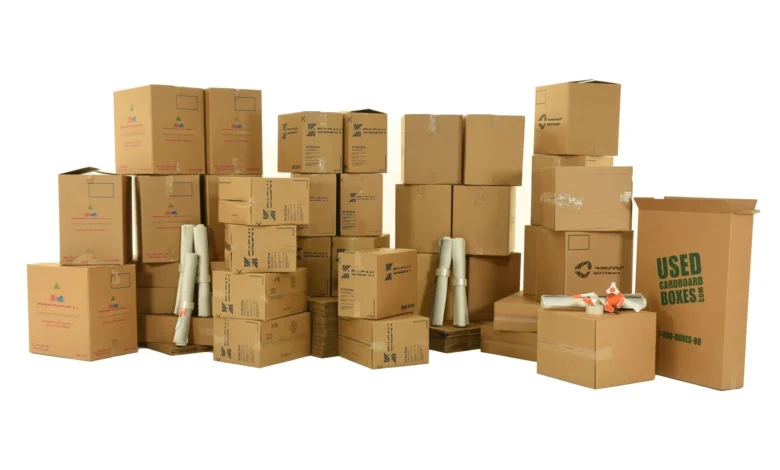Consumer-Centric Packaging: Meeting Evolving Needs and Expectations

In the dynamic landscape of modern consumerism, packaging has transitioned beyond its traditional role of safeguarding products. Today, it serves as a powerful tool that resonates with the desires and expectations of consumers. Packaging is no longer just a wrapper; it is an intricate interface that connects brands with their audience on a profound level.
Marty Metro, CEO of UsedCardboardBoxes.com, shared his journey of responding to consumer needs for convenient packaging. Metro recalled, “My wife and I were driving across the country, and I saw a moving truck. I just looked at her and said, ‘What do people do with their used moving boxes?” We did some research and realized millions of people move every year. “Let’s set up a website where people can trade their boxes.”
So that is exactly what they did. They created a website to allow people to purchase USED moving boxes if they need them, and sell the USED moving boxes they had, after their move. We learned a crucial lesson,“Ideas are worthless. My idea was worthless. The execution of the idea is where you create value, and profitable execution is where you make money.” He says. “The execution of our business model and logistics was completely flawed, and the idea failed miserably.” We had to shut down the entire operation and start over in 2006. That’s when I met David Krasnow, the tech-saavy venture capitalist that ultimately became my business partner. We raised capital and launched not just an idea, but a tech-centric, national infrastructure for large-scale box reuse that has grown continuously over the last 18 years! Now, our company manages not just box reuse programs, but UCBZeroWaste runs comprehensive waste reduction programs for some of the biggest companies in the country!
Consider the surge in packaging that prolongs product freshness. Vacuum-sealed bags for snacks or resealable containers for beverages are examples of how packaging innovation is meeting the demand for longer-lasting product quality.
For example, one can find QR codes on food packaging that provide nutritional information or interactive labels that offer cocktail recipes. This highlights how brands are leveraging technology to enhance the utility of their packaging.

Marty Metro — eco-entrepreneur and CEO — UsedCardboardBoxes & UCBZeroWaste (UCB)
The global market is characterized by a melting pot of cultures, each with its unique preferences and symbols. Packaging that embraces this diversity can make a significant impact. For instance, during traditional festivals or holidays, brands can customize their packaging to incorporate relevant symbols and colors, effectively becoming part of the celebration.
Metro’s insights reinforce the transformative power of technology in packaging. He remarked, “We learned to integrate with clients’ inventory systems and provide solutions that work just as well as what they were using but at a lower cost.” This adaptability and value-driven approach are indicative of how technology can enhance packaging strategies.
In an era of increasing cultural diversity and social awareness, packaging design has evolved beyond aesthetics and functionality—it has become a reflection of values, beliefs, and identity. Brands are recognizing the power of aligning their packaging strategies with cultural and social considerations to establish meaningful connections with their diverse consumer base.
Metro shared his perspective on cultural considerations. “Ideas are worthless. My original idea was worthless. The execution of the idea is where you create value, and profitable execution is where you make money.” He says. This insight underscores the importance of not just conceptualizing cultural considerations but effectively integrating them into packaging design.
Brands are responding by incorporating social responsibility into their packaging strategies. This could involve using eco-friendly materials, promoting charitable causes through packaging, or adopting transparent labeling to inform consumers about the origin and impact of their products.
Sustainability and innovation are also converging through the development of biodegradable materials and edible packaging. Brands are exploring ways to minimize environmental impact by using materials that decompose naturally or are safe for consumption. This aligns with consumer desires for both eco-friendliness and unique packaging experiences.
As cultural and social factors influence packaging design, authenticity becomes paramount. Brands that genuinely embrace diversity and social responsibility resonate more effectively with consumers. Metro’s journey with UsedCardboardBoxes.com exemplifies the growth that arises from aligning values with packaging strategies. From their initial concept of recycling moving boxes to becoming a partner in waste reduction, they have proven that authenticity and value-driven packaging can lead to flourish.
The evolution of consumer-centric packaging is an ongoing journey, marked by constant innovation and adaptation. As brands look toward the future, several exciting possibilities emerge that have the potential to reshape the packaging landscape and further elevate consumer experiences.
For example, digital printing technology is enabling personalized packaging on a large scale. Brands can create packaging for a certain demographic or even individual consumers. This not only deepens brand loyalty, but shows how companies can work towards a future where different technologies are used to create the most effective packaging.
Metro provides insights into the importance of envisioning the future. He shared, “I see our company on a much larger scale, with different divisions led by their own leaders, driven by their unique customer demands.” This forward-thinking approach reflects the dynamic nature of the packaging industry and the importance of staying ahead of trends.
While the evolution of consumer-centric packaging presents exciting opportunities, it also brings to light a range of challenges and ethical considerations that brands must navigate in their pursuit of meeting evolving consumer needs.
Ethical considerations come to the forefront when exploring the use of biodegradable and compostable materials. While these materials offer environmental benefits, they might not always align with a brand’s social responsibility goals. The potential conflicts between ethical practices and practical solutions underline the need for comprehensive assessments.
Transparency in packaging claims is another ethical concern. As brands focus on sustainability and eco-friendliness, consumers demand transparency about the materials used, sourcing practices, and overall environmental impact. Brands must ensure their claims are accurate and backed by evidence to avoid consumer mistrust.
Social and cultural considerations also pose challenges, especially in a global marketplace. Packaging designs that resonate with one culture might inadvertently offend another. Navigating these challenges requires sensitivity and thorough research to create packaging that transcends cultural barriers and resonates positively with diverse audiences.
The rapid pace of technological advancements raises questions about digital privacy and security. Smart packaging that collects consumer data for personalized experiences must prioritize data protection and ensure that consumer consent is obtained for such interactions.
One cannot overlook the potential environmental impact of advanced technologies. The integration of electronics, sensors, and batteries in smart packaging may contribute to electronic waste unless sustainable disposal methods are considered.
As brands embrace innovative packaging materials and designs, they must also address concerns about accessibility. Packaging should remain user-friendly for individuals with diverse abilities, ensuring that everyone can enjoy products without barriers.
Additionally, the concept of package-less shopping is emerging as a disruptive trend. Retailers are experimenting with bulk sections where consumers can bring their reusable containers to fill with products, minimizing packaging waste. This trend aligns with the growing movement toward zero waste and sustainable consumption.
The evolution of consumer-centric packaging is not just theoretical—it’s unfolding in the real world through innovative case studies and emerging trends that offer a glimpse into the future of packaging design.
Metro’s journey with Used Cardboard Boxes.com is another testament to the power of innovative packaging. What started as a simple idea transformed into a waste reduction partnership that saved millions for brands while reducing environmental impact. This highlights the potential of aligning packaging strategies with broader sustainability goals.
Manufacturers, are pivotal in driving innovation and producing eco-friendly materials. The development of biodegradable and compostable packaging materials is a result of manufacturers responding to the demand for sustainable alternatives. By investing in research and development, manufacturers contribute to the evolution of packaging materials that align with consumer expectations.
Consumers hold significant influence as well. Their purchasing decisions shape market demand and influence brands to adopt sustainable practices. Brands are increasingly responsive to consumer preferences, realizing that aligning packaging strategies with consumer values is key to long-term outcome.
Regulatory bodies and policymakers also play a crucial role in shaping the packaging landscape. By implementing regulations that encourage sustainable practices and discourage excessive waste, they create a framework that guides brands and manufacturers toward responsible packaging choices.
Emerging trends, such as extended producer responsibility (EPR) programs, exemplify collective responsibility. EPR programs hold brands accountable for the entire lifecycle of their products, including packaging waste management. This approach encourages brands to design packaging with end-of-life considerations in mind.
Moreover, cross-industry collaboration is gaining traction. Brands are partnering with non-profit organizations, sustainability advocates, and even competitors to address packaging challenges collectively. By sharing knowledge, resources, and best practices, these collaborations drive progress toward more sustainable packaging solutions.
Metro underscores the importance of collaboration and value-driven execution. He shared his journey of partnering with clients to find solutions that align with their needs. “The way we operate is not as a vendor but as a partner. When we engage with a clientin the creative process, our focus is on being a waste reduction partner. This involves deep involvement with our clients, implementing internal process changes, equipment adjustments, and occasionally internal product modifications. Our goal is to collaboratively drive down the overall cost of waste in a true partnership, not as a mere vendor.”Metro highlights. This collaborative approach has been instrumental in not only creating value for businesses but also contributing to broader waste reduction efforts.
Today, UsedCardboardBoxes.com works with many of the largest and most recognizable companies in the US. Some include Best Buy, Big Lots, Califia Farms, Dole, Family Dollar/Dollar Tree, Foot Locker, General Mills, Goodwill, Kellogg’s, Keurig, McCormick Spice, Munchkin, Menards, Nestle, Pepsi, Schnitzer Steel, TJMaxx/Marshalls, Trex, Upfield, Walgreen’s, and more.
From convenience-driven designs to embracing cultural and social considerations, packaging has transformed into a tool that not only protects products but also enhances user experiences. Real-world case studies and new trends have showcased the power of innovation, technology, and sustainability in shaping the future of packaging design.
It’s crucial to remember that packaging is more than just a container—it’s a bridge between brands and consumers, a reflection of values, and a catalyst for change. By embracing the lessons learned from both industry experts and real-world experiences like Metro’s, the packaging industry can embark on a path that not only resonates with consumers today but also contributes to a brighter tomorrow.



